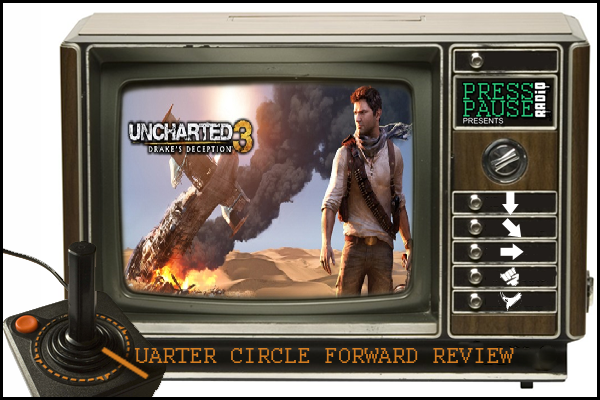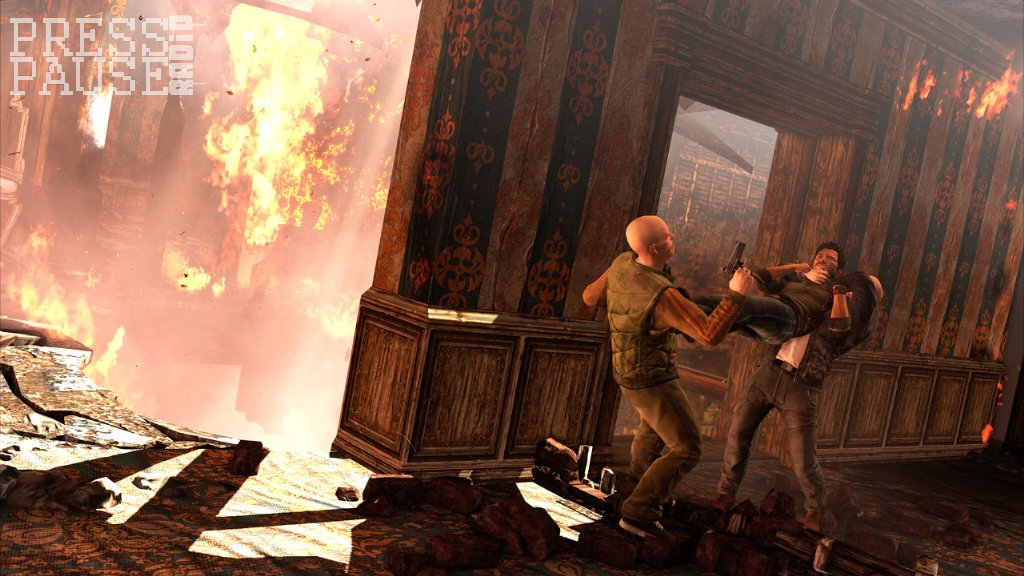
The words of T.E. Lawrence slowly initiate the start to the latest caper of Nathan Drake. Alongside him is his best friend and patriarch, Victor “Sully” Sullivan. With a toss of his cigar against the gutters of London and its bustling nightlife, the two make headway for the beginning of their latest quest for glory. Naughty Dog has had their work cut out for them with follow-up of the critically acclaimed Among Thieves, and Drake’s Deception doesn’t pull any punches…in more ways than one.
There are so many aspects to touch on in this latest installment, but I’ll start off with the most noticeable improvement: the combat. Uncharted has always instilled a focus on utilizing environmental conventions for an ever changing strategy towards your combat. Whether you hung from a building’s edge and threw an unsuspecting enemy below, or traded off cover and blind fire from a superior vantage point, the key to your success is dependent on how you assessed your surroundings, and determined if you’re going gung-ho or advance vigilantly in the art of breaking necks .
Drake’s Deception advances the element of interaction with your environment through a contextual awareness of objects or set pieces within your given area, which augments your odds when defending against goons. Fighting near tables with bottles prompts drake to grab them and smash them against your opponent’s skull in one concussive attack that’s seamlessly integrated into your melee combo. These types of elements -- like doors that are slammed into enemies or pipes leaning against crates that are picked in the same fashion -- are all contextual within Nate’s reach, and add a subtle but very effective layer to your combat that doesn’t feel gimmicky in the slightest, while adding to the implied portrayal of Nate’s improvised fist-fighting.

The "fisticuff" mechanics are also enhanced with the ability of being able to grab and throw your opponents (again using your environment with the new contextual advancements, with the set pieces allow more control towards your approach in combat). Enemies can also grab you, and you're able to counter through timed button presses of the circle button, which adds to the returning counter system from Among Thieves. Surrounding enemies, however, can now attack you in a moment's notice when you’re engaged with another opponent. You’ll have to actively counter within your combo attacks (reminiscent of the combat system from Rocksteady’s Batman Arkham series), but in askew of its frenetic style in favor of the structured brawling in the Uncharted series.
Joining the average rank of the gun-toting goons you overcome is a new brute class of enemy. The brute class will immediately charge at you, and if his tackle successfully connects with you then he will knock away your long gun, coaxing you into retaliating with some knuckle warfare instead. The fights with brute enemies incorporate a sense of desperation and vulnerability to intensify your struggled attacks, but blends your counter techniques into a cohesive defense that eventually brings the behemoth down. Brute encounters don’t feel dialed-in or tacky, and keep battles fresh as you stammer for your firearms before the big bastard clotheslines you into a fight for survival. All of the existing combat tactics were also refined for seamless transition between combat and gun play. For example, steel-fisting an opponent (softening an enemy with a few bullets before delivering a finishing blow with your fists) will have you catch any long gun they may have been carrying, so you can shift right into defensive fire against long distance foes.
Touching on the environments found in Uncharted 3, the journey may completely steal your attention from the task at hand, leaving you satisfied with every second you stare. Travels take place from London to France, from Syria to Yemen. The articulate attention to every detail of culture and lore relating to your current region delivers an artificial sensation of travel extending beyond the reach of any geographic documentary you’ve experienced beforehand. This is accomplished through improvements behind every aspect of the graphics engine, from Drake’s Fortune and Among Thieves to where motion capture covers articulated points of movement within facial expressions, which will have you double-taking as you progress. Environmental effects of sand, water, and fire are portrayed in conjecture to their real-life composition and application will sell the presentation within the visuals enough to surpass the lofty standard that Among Thieves had set before it. Sadly, I have yet to experience the visuals in 3D, as I don’t own a 3D television. But rest assured, I will definitely add an addendum the moment I get the chance to do so.

"The immersion of the human element has never ever before been so immaculately translated into a video game."
The premise of Drake’s Deception works towards delivering the intensity that Among Thieves injected into the narrative’s formula, but consistently builds upon the character development; these moments of character growth truly blur any distinguishable lines between fantasy and reality within interactive media. The immersion of the human element has never been so immaculately translated into a video game. The narratives exchanged between characters are carried out with such an articulate performance that the presentation will openly appeal to anyone within the direct vicinity of the gameplay.
The plot -- focusing towards unveiling the origins of Nathan and company -- has been very cloudy and fleshed in such a paced manner to where you dive into the depths of how Drake discovered his ancestry to Sir Francis Drake, and how he first met Sully. The plot development is reminiscent of Uncharted’s cinematic inspiration, Indiana Jones series with third entry The Last Crusade interpreted into moments of tasteful homage, which will appeal to any traditional action fan. As for the fusion of history, Drake’s deception returns back to Sir Francis Drake, and touches on a secret royal expedition that he carried out for Queen Elizabeth during his real life circumnavigation in the 1580’s. Spotlighting the East-Indies within his travels, Naughty Dog found a way to tie the fictional ancestry of Nathan to Sir Francis, while still exploring the life of T.E. Lawrence during his time in Arabia. Detailing his interest in the fabled Iram of the pillars, to the added effect of his real life motorcycle death being a part of a conspiracy cover-up by the clandestine organization led by antagonist Katherine Marlowe. This labored mixture of fiction and fact strays very far from ever feeling contrived and will push your drive to continue every bit as much as the action does.

Multiplayer and Cooperative play returns to Uncharted 3, with much more streamlined the second time around, with a refined interface towards load-outs and match lobbies long with a new buddy dynamic in Deathmatch that completely alters your approach in play for the better. Maps are based around the same settings you encounter within the campaign, but are reduced for a more compact arena for play along with action cut segments specific to the stage. For instance, speeding parallel trains within a narrow tunnel in the London underground, or speeding jeeps chasing an aircraft carrier down a runway before takeoff. The action dynamic from the campaign is delightfully translated in a multiplayer setting, and will have you apply your skill with gunplay and repressed melee system with applied balancing towards the steel-fist techniques while leaving the stealth attack system fully tact. During combat you’ll constantly have changing conditions that are providing different advantages for the team of players that affect your performance or handicap your odds of victory that will refresh every round from ever getting stale after hours of play.
Modes in multiplayer include Standard Team Deathmatch of five versus five or Three Team Deathmatch with groups consisting of just two teammates. The other modes are Plunder, which is a modified take on Capture the flag for the Uncharted series, and Free For All, which has every man out for blood against all comers.
The Load-out system is made up of four different slots with your choice of pistol, long gun, booster perks, and medal kickback awards you’ll gain access to after a certain amount of successive kills. The cooperative mode resembles more of combat dynamics from the campaign as you it’s essentially a horde mode catered for Uncharted 3 with varied conditions like killing within a restricted territory that nullifies any kills made outside its boundaries, treasure collecting through a one sided capture the flag formula or good old fashioned survival against enemy waves. The cooperative aspect is bolstered by vantage tactics depending on enemy formations, as well certain enemies who will lock you in desperate headlock that will need to be thwarted by your partner as soon as possible as while your struggle against getting your neck broken.
Uncharted 3 was tasked with the feat of topping its critically acclaimed predecessor, and it does this in spades and shotguns alike. Imbued with a universal appeal that captures anyone who starts it, the award-winning video game formula has transcended into its apex and is no longer a video game but an interactive masterpiece that should be experienced by everyone.